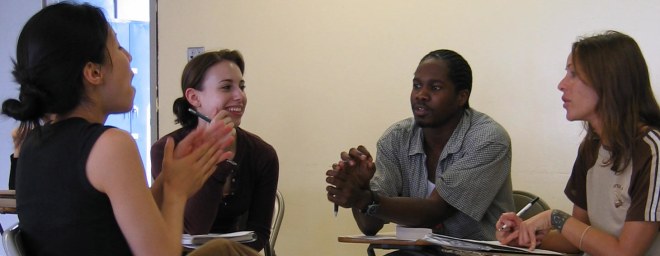In my technology management classes at BCIT I seek to create an environment where my students are open to learning. I strive to create a climate where students are comfortable, feel free to express their opinions, and share stories about business situations which lead to classroom discussion.
At the beginning of each term I start my courses with a round of introductions, ensure I learn my students’ names, create clear expectations for assessment and coursework, and nurture opportunities for students to meet one another in paired discussions, create trust and bond during the course, and learn from one another as well as from me.
I am always keen to learn more on the topic of creating a positive learning environment for students, so I turned to scholarly papers as well as to online articles on to see what other tools and techniques I could adopt to facilitate my students’ learning.
Barge (2014) presents a handy one-page checklist for teachers to create a “well-managed, safe and orderly environment that is conducive to learning, and encourages respect for all”. He bases his list on “good discipline, effective routines, smooth transitions and ownership of the environment”. Some of the tactics that he proposes involve creating a comfortable physical environment and “preparing and organizing the materials and framing the lessons in a logical and coherent manner”.
He notes, however, that a positive learning environment is not simply a matter of organization and class layout. Trust is important as well. In a positive learning environment “risk-taking is welcome, engagement is the norm and authentic conversations occur”. This can only happen in a nurturing space where students feel psychologically safe, where their self-image is preserved, where they feel they belong, the lessons and actions are purposeful and where learners derive a sense of competence.
Taylor (n.d.) believes that learning is facilitated by humour. It “facilitates retention of novel information, increases problem solving, relieves stress and increases perceptions of teacher credibility”. One does not need to become a stand-up comedian to use humour in the classroom: a simple attitude of smiling often and being light-hearted, spontaneous and natural may suffice. Relaxing control, opening conversation with humour – perhaps by using stories or relating everyday events – works well. Adding a touch of tasteful humour into lectures also helps relax the mood in the class, and opens students to new information.
In a short article for the Association for Supervision and Curriculum Development, Alfred (2008) draws a short list of actions to enable learning: present a classroom code of conduct during the first class, make classes relevant, teach positive actions, reinforce positive behaviours, be a good role model (and point to other positive role models), and always remain positive.
An article on the Gwenna Moss Centre for Teaching Effectiveness (n.d.) web site also underscores respect for the individual as a building block for learning environment – learn the students’ names, encourage them to participate in class, listen to what they have to say and incorporate highlights into teaching materials and respect their contributions. Also, organize the physical environment, be organized, involve some humour in class and encourage the students to loosen up as well; establish norms of conduct, be respectful of students’ inputs, and highlight their contributions.
In summary, creating a positive learning environment requires attention to a number of important vectors: creating such an environment is not only a matter of maintaining a comfortable physical space, but also requires organized lectures with clear expectations, a lighthearted environment where the student is respected, engagement is encouraged and two-way communication is highlighted. The focus is not only on the physical space, but also on the climate of the heart: a space where, as Barge(2014) reminds us, a class can meet in an atmosphere of “trust, fairness, caring, respect and enthusiasm”.
As I prepare for a new set of classes beginning in April, I will keep these wise directives in mind. I will continue to prepare my classes and set expectations ahead of time, I will work on instilling a light-hearted yet focused learning environment with diverse activities to engage my students, and I will continue to encourage discussions.

References
Alfred, C. (2008). “Seven Strategies for Building Positive Classrooms”. Educational Leadership, Association for Supervision and Curriculum Development. Retrieved from
http://www.ascd.org/publications/educational-leadership/sept08/vol66/num01/Seven-Strategies-for-Building-Positive-Classrooms.aspx
Barge, J. (2014). “Teacher Assessment on Performance Standard 7: Positive Learning Environment”. TKES Quick Guide, Georgia Department of Education. Retrieved from https://www.gadoe.org/School-Improvement/Teacher-and-Leader-Effectiveness/Documents/FY15%20TKES%20and%20LKES%20Documents/QG%20-%20TKES%20-%20TAPS%207%20Positive%20Learning%20Environment.pdf
Gwenna Moss Centre for Teaching Effectiveness (n.d.). “Building a Positive Learning Environment”. University of Saskatchewan. Retrieved from
http://www.usask.ca/gmcte/resources/teaching/environment
Taylor, A. (n.d.). “Laugh and Learn”. Humber Centre for Teaching and Learning. Retrieved from http://www.humber.ca/centreforteachingandlearning/assets/files/Teaching%20Resources/01%20Laugh%20and%20Learn-B.pdf